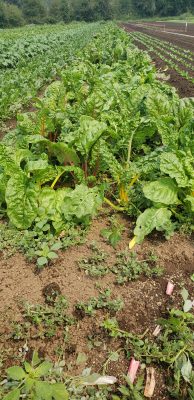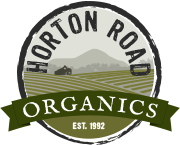Swiss chard… just hearing those words brings to mind bright, beautiful colors and an earthy, sweet flavor. But aside from being quite the showy vegetable on the stand or in your box, swiss chard brings a lot to the table.
First, as a farmer, swiss chard is a pretty awesome crop in that the same plant can be harvested many times. Here at Horton Road we only plant chard twice a season, one bed each time, and that provides all the chard the farm will sell all season long. Swiss chard can do this in part because it is a very versatile plant that can handle a fairly wide range in weather and also since we harvest and eat the leaves of the plant, the more we pick, the more the plant works to replace its foliage. The variety of swiss chard we grow is called Bright Lights, and as you have seen produces an amazing array of colorful stems and hues of leaves. Despite the differences in color all chard shares a comparable taste and nutrition.
Swiss chard is closely related to the beet, accounting for its similar earthy, sweet flavor, and most likely evolved/was bred from a wild beet variety in such a way that its leaves are the primary edible versus the root.
Swiss chard’s origins can be traced to southern Europe many thousands of years ago, and so surprisingly is not native to Switzerland. It seems that swiss chard has been known by many names across the years so tracing it’s exact history is a bit tricky but references have been found dating back at least as far as the ancient Greeks. Swiss chard made it to North America accompanying the colonizers who traveled to this continent’s shores from Europe.
Swiss chard is packed full of important vitamins and minerals, most notably: vitamin A, magnesium, phosphorous and potassium. Swiss chard keeps best in a plastic bag in your crisper drawer in your refrigerator and should be enjoyed in a couple days time for best quality. Chard stems can be eaten and cooked and will keep longer than the leaves if stored separately. Enjoy!

Fall planting of swiss chard at Horton Road.
Info for this post gleaned from the following sources:
https://extension.illinois.edu/veggies/chard.cfm
http://www.cliffordawright.com/caw/food/entries/display.php/topic_id/6/id/36/
Laura is a first-year apprentice at Horton Road.
